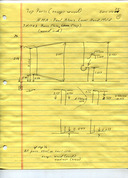These Notebooks contain photographs and measured drawings (which are not quite the same as not engineering drawings) [1], of a 19th century lever hand mold.
This mold is for pica body type (and is actually very close to 12 point). Its nick is in the standard position for American/English type. It is probably of American origin, and is of what I'm calling a "composite" style of construction. That is, it is built on base plates in the French style, but has wings in the German/Flemish/English instead of French-style potences (male & female gauges). It is clearly of hand construction; there is no sign in it of the regularity of form produced machine tools. (This is especially apparent when you put it on a surface plate and start trying to measure it!) It has a couple of modern screws, and certain parts have been reshaped by modern filing (we don't know when or by whom). It is complete and in fully functional condition (though I did not cast from it). No matrices are known for this mold. [3], [4],
As to its date: It cannot be earlier than 1811 (the date of the earliest of Binny's patents which, we presume were for the lever hand mold). Since the purpose of the lever hand mold was speed in hand casting, it is exceedingly unlikely to be later than the widespread adoption of the pivotal type caster by the mid 1850s. So I think it would be safe to say that it is between 160 and 200 years old.
The maker and provenance of this mold are unknown to me, though there is no reason to believe that it is other than American in its origin. The designation "HMA" (Hand Mold, item A) is just my own "machine code" for it in the CircuitousRoot Parts Symboling System. (See Parts Symboling Scheme [for hand molds] and also the general Notebook on Parts Symboling Systems.)
My thanks to Paul Aken, proprietor of The Platen Press museum, for the loan of this mold from his collection. This mold is now in the collection of Patrick Goossens' Letter-kunde Press, Antwerp.

Measured Drawings
The PDF linked at left contains scans of my scribbled notes taken when measuring this mold. These hardly count as "measured drawings," but they do have all of the data available to me. Together with the photographs, these measurements should allow the construction of a reasonable facsimile of this mold. I wuld be delighted if someone would do this.
1. A measured drawing shows something as it is (to some degree of completeness). An engineering drawing shows something as it should be.
I've opted against doing 3-D models of it. When you start looking really closely, this mold is actually a quite irregular hand-crafted object (aside from the casting surfaces themselves, of course, which are quite precise hand-crafted objects). A digital 3-D model of this particular mold would have to be done using 3-D scanning and relatively advanced rendering software.
2. The Body is 0.167 as measured. A pica is 0.166, but allowing for 0.2 percent shrinkage of the type this would put the body size of this mold somewhere around 0.164.
The mold depth is 0.7605 as measured. We know neither the type height or the matrix depth of drive for which which this mold was intended. If we run the numbers for 0.918 type height, we get a depth of drive of either 0.157 (ignoring shrinkage) or 0.159 (at 0.2% shrinkage) Both of these would be unusually deep for pica type. This suggests that the type height for which this mold was intended was less than post-1886 American type height.
3. If, as I believe, lever hand molds took matrices with a hole in the back rather than the slot used with conventional hand molds, it is more than likely that whatever matrices were used with this mold continued into production with a pivotal type caster.
4. By chance I have a matrix font which, while of the wrong body size did physically fit this mold. These mats were used in the photographs here.
All portions of this document not noted otherwise are Copyright © 2015, 2023 by David M. MacMillan.
Circuitous Root is a Registered Trademark of David M. MacMillan.
This work is licensed under the Creative Commons "Attribution - ShareAlike" license, version 4.0 International. See http://creativecommons.org/licenses/by-sa/4.0/ for its terms.
Presented originally by Circuitous Root®